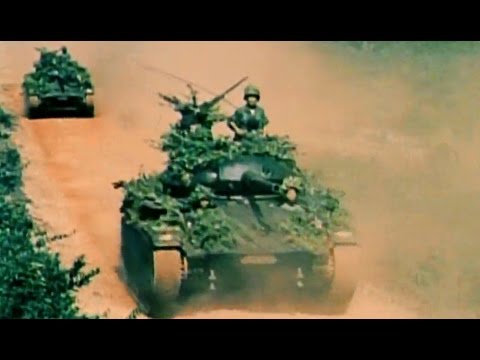more at
“This issue of THE BIG PICTURE presents a documentary report on the activities of the U.S. Army, Air Force and Navy and their combined effort to help stamp out the threat of communism in South Vietnam. Filmed on location, camera crews widened their coverage to include the composite story of the U.S. Military Assistance Program in this troubled nation. In order to preserve the rights and freedoms of a free people, the United States Armed Forces are training the Vietnamese in order that they will be able to continue to fight the threat of communism.”
The Big Picture episode TV-574
The Big Picture TV Series playlist:
Vietnam War playlist:
Public domain film from the US National Archives, slightly cropped to remove uneven edges, with the aspect ratio corrected, and mild video noise reduction applied.
The soundtrack was also processed with volume normalization, noise reduction, clipping reduction, and/or equalization (the resulting sound, though not perfect, is far less noisy than the original).
…In the 1960 U.S. presidential election, Senator John F. Kennedy defeated incumbent Vice President Richard Nixon. Although Eisenhower warned Kennedy about Laos and Vietnam, Europe and Latin America “loomed larger than Asia on his sights.”…
In 1961, the U.S. had 50,000 troops based in Korea, and Kennedy faced a three-part crisis – the failure of the Bay of Pigs Invasion, the construction of the Berlin Wall, and a negotiated settlement between the pro-Western government of Laos and the Pathet Lao communist movement…
By November 1963, there were 16,000 American military personnel in South Vietnam, up from Eisenhower’s 900 advisors…
The Strategic Hamlet Program was initiated in late 1961. This joint U.S.-South Vietnamese program attempted to resettle the rural population into fortified camps. It was implemented in early 1962 and involved some forced relocation, village internment, and segregation of rural South Vietnamese into new communities where the peasantry would be isolated from Communist insurgents…
The inept performance of the South Vietnamese army was exemplified by failed actions such as the Battle of Ap Bac on 2 January 1963, in which a small band of Viet Cong won a battle against a much larger and better-equipped South Vietnamese force, many of whose officers seemed reluctant even to engage in combat…
U.S. officials began discussing the possibility of a regime change during the middle of 1963. The United States Department of State was generally in favor of encouraging a coup, while the Defense Department favored Diệm…
The Central Intelligence Agency (CIA) was in contact with generals planning to remove Diệm. They were told that the United States would not oppose such a move nor punish the generals by cutting off aid. President Diệm was overthrown and executed, along with his brother, on 2 November 1963…
U.S military advisors were embedded at every level of the South Vietnamese armed forces. They were however criticized for ignoring the political nature of the insurgency. The Kennedy administration sought to refocus U.S. efforts on pacification and “winning over the hearts and minds” of the population…
Paramilitary officers from the CIA’s Special Activities Division trained and led Hmong tribesmen in Laos and into Vietnam. The indigenous forces numbered in the tens of thousands and they conducted direct action missions, led by paramilitary officers, against the Communist Pathet Lao forces and their North Vietnamese supporters.The CIA also ran the Phoenix Program and participated in Military Assistance Command, Vietnam – Studies and Observations Group (MAC-V SOG), which was originally named the Special Operations Group, but was changed for cover purposes…

